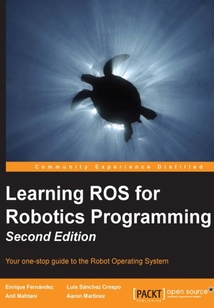舉報 

會員
Learning ROS for Robotics Programming(Second Edition)
最新章節:
Index
Ifyouhaveevertriedbuildingarobot,thenyouknowhowcumbersomeprogrammingeverythingfromscratchcanbe.ThisiswhereROScomesintothepicture.Itisacollectionoftools,libraries,andconventionsthatsimplifiestherobotbuildingprocess.What’smore,ROSencouragescollaborativeroboticssoftwaredevelopment,allowingyoutoconnectwithexpertsinvariousfieldstocollaborateandbuilduponeachother'swork.Packedfullofexamples,thisbookwillhelpyouunderstandtheROSframeworktohelpyoubuildyourownrobotapplicationsinasimulatedenvironmentandshareyourknowledgewiththelargecommunitysupportingROS.Startingatanintroductorylevel,thisbookisacomprehensiveguidetothefascinatingworldofrobotics,coveringsensorintegration,modeling,simulation,computervision,navigationalgorithms,andmore.Youwillthengoontoexploreconceptsliketopics,messages,andnodes.Next,youwilllearnhowtomakeyourrobotseewithHDcameras,ornavigateobstacleswithrangesensors.Furthermore,thankstothecontributionsofthevastROScommunity,yourrobotwillbeabletonavigateautonomously,andevenrecognizeandinteractwithyouinamatterofminutes.What’snewinthisupdatededition?Firstandforemost,wearegoingtoworkwithROSHydrothistimearound.Youwilllearnhowtocreate,visualize,andprocessPointCloudinformationfromdifferentsensors.ThiseditionwillalsoshowyouhowtocontrolandplanmotionofroboticarmswithmultiplejointsusingMoveIt!Bytheendofthisbook,youwillhaveallthebackgroundyouneedtobuildyourownrobotandgetstartedwithROS.
目錄(108章)
倒序
- coverpage
- Learning ROS for Robotics Programming Second Edition
- Credits
- About the Author
- Acknowledgments
- About the Author
- Acknowledgments
- About the Author
- Acknowledgments
- About the Author
- Acknowledgments
- About the Reviewer
- About the Reviewer
- Acknowledgments
- About the Reviewers
- www.PacktPub.com
- Support files eBooks discount offers and more
- Preface
- What this book covers
- What you need for this book
- Who this book is for
- Conventions
- Reader feedback
- Customer support
- Chapter 1. Getting Started with ROS Hydro
- PC installation
- Installing ROS Hydro – using repositories
- How to install VirtualBox and Ubuntu
- Installing ROS Hydro in BeagleBone Black (BBB)
- Summary
- Chapter 2. ROS Architecture and Concepts
- Understanding the ROS Filesystem level
- Understanding the ROS Computation Graph level
- Understanding the ROS Community level
- Tutorials to practice with ROS
- Summary
- Chapter 3. Visualization and Debug Tools
- Debugging ROS nodes
- Logging messages
- Inspecting what is going on
- Setting dynamic parameters
- When something weird happens
- Visualizing node diagnostics
- Plotting scalar data
- Image visualization
- 3D visualization
- Saving and playing back data
- Using the rqt_gui and rqt plugins
- Summary
- Chapter 4. Using Sensors and Actuators with ROS
- Using a joystick or a gamepad
- Using a laser rangefinder – Hokuyo URG-04lx
- Using the Kinect sensor to view objects in 3D
- Using servomotors – Dynamixel
- Using Arduino to add more sensors and actuators
- Using an ultrasound range sensor with Arduino
- How distance sensors send messages
- Using a low-cost IMU – 10 degrees of freedom
- Using a GPS system
- Summary
- Chapter 5. Computer Vision
- Connecting and running the camera
- Writing your own USB camera driver with OpenCV
- Calibrating the camera
- The ROS image pipeline
- ROS packages useful for Computer Vision tasks
- Using visual odometry with viso2
- Performing visual odometry with an RGBD camera
- Computing the homography of two images
- Summary
- Chapter 6. Point Clouds
- Understanding the point cloud library
- My first PCL program
- Segmentation
- Summary
- Chapter 7. 3D Modeling and Simulation
- A 3D model of our robot in ROS
- Creating our first URDF file
- Xacro – a better way to write our robot models
- Simulation in ROS
- Summary
- Chapter 8. The Navigation Stack – Robot Setups
- The navigation stack in ROS
- Creating transforms
- Publishing sensor information
- Publishing odometry information
- Creating a base controller
- Creating a map with ROS
- Summary
- Chapter 9. The Navigation Stack – Beyond Setups
- Creating a package
- Creating a robot configuration
- Configuring the costmaps – global_costmap and local_costmap
- Creating a launch file for the navigation stack
- Setting up rviz for the navigation stack
- Adaptive Monte Carlo Localization
- Modifying parameters with rqt_reconfigure
- Avoiding obstacles
- Sending goals
- Summary
- Chapter 10. Manipulation with MoveIt!
- The MoveIt! architecture
- Integrating an arm in MoveIt!
- Simple motion planning
- Motion planning with collisions
- The pick and place task
- Summary
- Index 更新時間:2021-07-16 20:46:08
推薦閱讀
- Java逍遙游記
- Spring Boot開發與測試實戰
- JavaScript語言精髓與編程實踐(第3版)
- Scratch 3游戲與人工智能編程完全自學教程
- Python數據分析從0到1
- Java項目實戰精編
- Unity 2018 Shaders and Effects Cookbook
- 詳解MATLAB圖形繪制技術
- Mastering Akka
- 網絡數據采集技術:Java網絡爬蟲實戰
- Learning VMware vSphere
- 從零開始學Selenium自動化測試:基于Python:視頻教學版
- INSTANT Apache ServiceMix How-to
- DevOps 精要:業務視角
- Less Web Development Cookbook
- 量子計算機編程:從入門到實踐
- Java面向對象程序設計教程
- Natural Language Processing with Python Cookbook
- C語言從入門到精通(微視頻精編版)
- Java算法從菜鳥到達人
- Java EE框架開發技術與案例教程
- 程序員超強大腦
- 計算機網絡基礎
- Java高級特性編程及實戰
- Network Backup with Bacula How-to
- 完美講堂 Unity3D游戲特效設計實戰教程
- Mastering Symfony
- Building Python Real:Time Applications with Storm
- 從零開始學C++程序設計
- Git:Mastering Version Control

